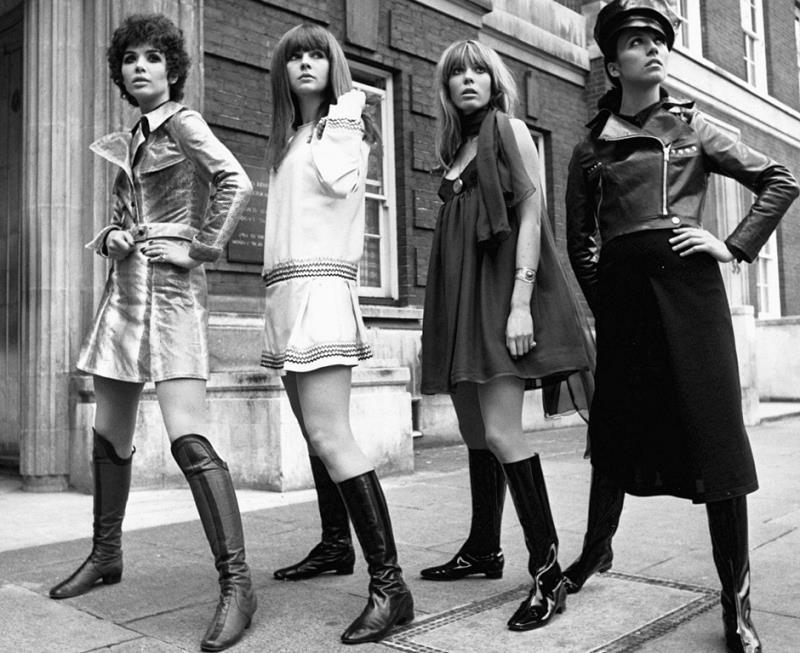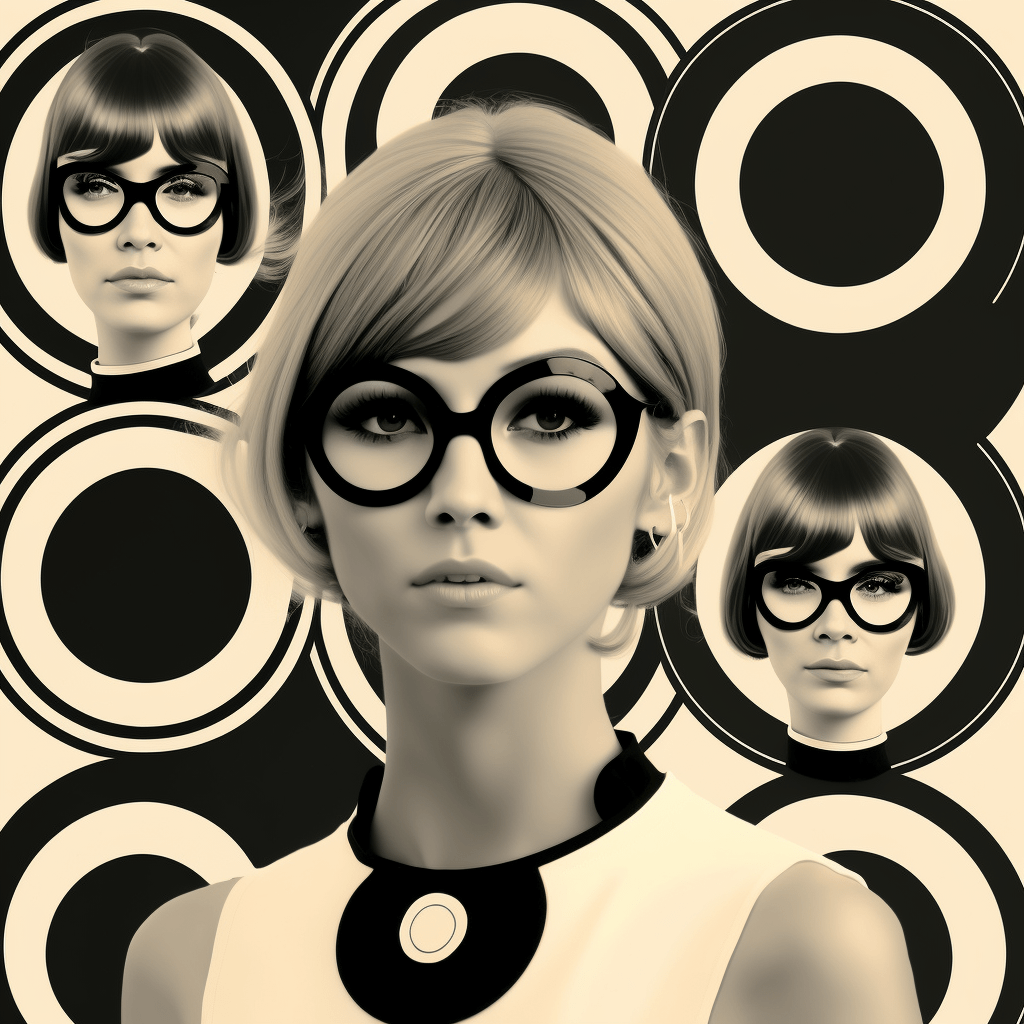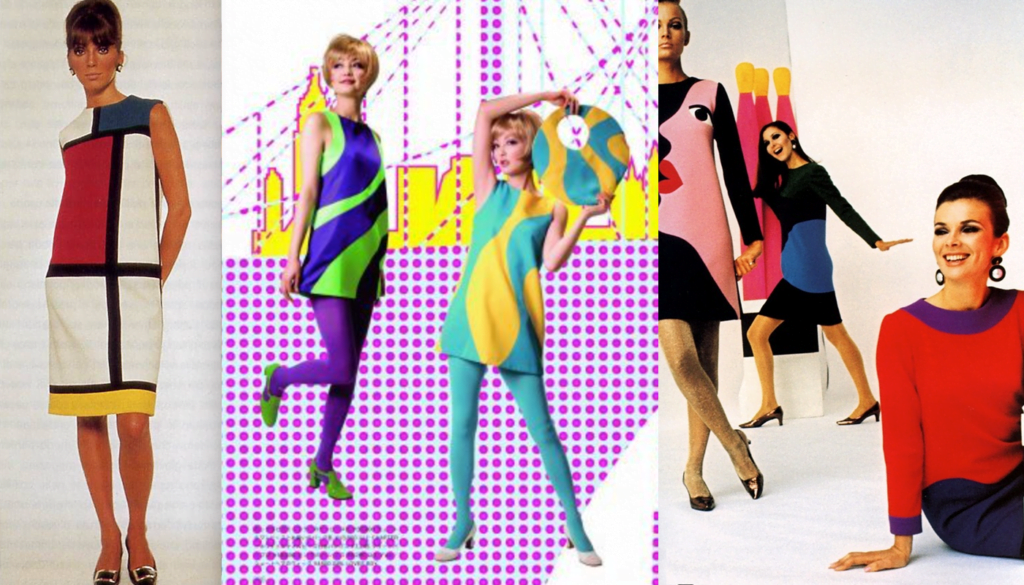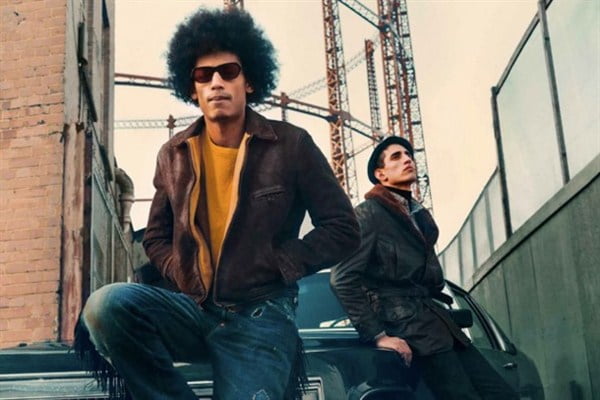
The 1960s was a decade of great change and experimentation in the world of fashion, and its legacy continues to be felt in the world of style today. From the shift towards youth culture and the rise of the mini skirt, to the influence of Pop Art and the lasting impact of 60’s fashion, this comprehensive guide offers an overview of the key trends and designers that defined the decade. So whether you’re a fashion historian, vintage clothing lover, or simply curious about the bold and innovative styles of the 1960s, read on to discover the lasting legacy of 1960s fashion.
Introduction to 60’s Fashion
Overview of 60’s fashion and its impact on the fashion industry In the 1960s, the fashion industry underwent a major transformation. The decade saw a rejection of the strict and conservative styles that dominated the 1950s and an embrace of bold, new silhouettes, bright colors, and innovative materials. According to the Victoria and Albert Museum, “The 1960s was a decade of great change and upheaval, both politically and culturally. This was reflected in the fashion of the time, as designers and consumers alike sought to break away from the strict and formal styles of the past.” The fashion of the 1960s had a profound impact on the industry and paved the way for many of the trends and styles that continue to be popular today.
Key designers and their contributions to 60’s fashion
The 1960s saw the rise of some of the most iconic designers in fashion history, including Mary Quant, André Courrèges, and Yves Saint Laurent. These designers challenged traditional notions of beauty and femininity and paved the way for a new generation of fashion. Mary Quant, for example, is widely credited with popularizing the mini skirt and helping to establish London as a hub of fashion and youth culture. According to Vintage Dancer, “Mary Quant is considered one of the most influential fashion designers of the 1960s, especially for her role in popularizing the mini skirt.” André Courrèges, on the other hand, was known for his futuristic designs, which incorporated clean lines, geometric shapes, and innovative materials. Yves Saint Laurent, meanwhile, was instrumental in bringing haute couture to the masses and revolutionizing the fashion world with his groundbreaking designs.
The cultural and societal influences on 60’s fashion
The 1960s was a decade of great cultural and social change, and this was reflected in the fashion of the time. Women, in particular, were challenging traditional ideas of femininity and seeking new forms of self-expression. This is evident in the emergence of bold, new styles like the mini skirt, which symbolized female empowerment and liberation. The youth culture of the time also had a significant impact on fashion, as young people sought to express their individuality and reject the conservative values of the past. The youth culture of the 1960s had a profound impact on fashion, as young people sought to express their individuality and reject the conservative values of the past.
Pop art, music, and film also played a significant role in shaping 60’s fashion, with artists like Andy Warhol and musicians like The Beatles influencing fashion trends and helping to establish the decade as one of the most iconic and influential periods in fashion history. The Metropolitan Museum of Art notes, “Pop Art and fashion were intertwined in the 1960s, with artists like Warhol and other members of the New York scene influencing the look of the era.”
Mod Fashion

Definition and origin of Mod fashion
Mod fashion emerged in the early 1960s as a subculture of young, fashionable Britons who sought to break away from traditional styles and embrace a new, modern look. The term “mod” is derived from the word “modern,” and the style was characterized by its focus on clean lines, bright colors, and innovative materials. Mod fashion was popularized by young, working-class people who were seeking a new form of self-expression and a way to distinguish themselves from their parents’ generation.
According to the Victoria and Albert Museum, “Mod was a youth-driven subculture that started in London in the late 1950s and peaked in the early to mid-1960s. Mods were concerned with looking sharp and modern, and they were influenced by Italian and French fashions, as well as American jazz and R&B music.” Mod fashion was characterized by its focus on individuality and self-expression, and it was often seen as a rebellion against the conservative values of the previous generation.

Key elements of Mod fashion and their significance
The key elements of Mod fashion included sharp, tailored suits, bold graphic prints, and bright, eye-catching colors. Mod clothing was often made from synthetic materials like PVC and nylon, which were new and innovative at the time. The mod look was characterized by its sleek, modern lines and attention to detail, and it was often accessorized with oversized sunglasses, chunky jewelry, and short, blunt haircuts. These elements helped to define the Mod style and set it apart from other fashion trends of the time.
The focus on clean lines, bright colors, and innovative materials in Mod fashion was a direct response to the conservative styles of the 1950s. According to Vintage Dancer, “The Mods wanted a fresh, new look that was different from the bland, conservative styles of the 1950s. They embraced a modern, futuristic aesthetic that was all about looking sharp and stylish.” The attention to detail in Mod fashion was also significant, as it reflected the importance that the subculture placed on personal appearance and style.
Key designers and their contributions to Mod fashion
Some of the key designers who helped to define the Mod style include Mary Quant, John Stephen, and Colin McGurie. Mary Quant, in particular, was instrumental in popularizing the mini skirt and establishing London as a hub of fashion and youth culture. According to Vintage Collector, “Mary Quant is considered one of the most influential fashion designers of the 1960s, especially for her role in popularizing the mini skirt.” John Stephen, on the other hand, was known for his bold, graphic prints and innovative materials, while Colin McGurie was celebrated for his use of bright, eye-catching colors. These designers helped to create the look and feel of Mod fashion, and their designs continue to be influential to this day.
The influence of Mod fashion on 60’s fashion
Mod fashion had a profound impact on 60’s fashion, as it helped to establish a new, modern aesthetic that was focused on clean lines, bright colors, and innovative materials. The Mod style was widely imitated and influenced many other fashion trends of the time, and it continues to be referenced and reinterpreted by designers today. The focus on youth culture and self-expression that was a hallmark of Mod fashion also had a lasting impact on the fashion industry and helped to establish the 1960s as one of the most iconic and influential periods in fashion history.
The influence of Mod fashion can be seen in the continued popularity of mini skirts, graphic prints, and bright colors, as well as in the continued
importance placed on individual style and self-expression in the fashion world. The clean lines and attention to detail that were hallmarks of Mod fashion continue to inspire designers and fashion lovers alike, and the subculture remains an important part of fashion history.
Mod fashion was a defining moment in the history of fashion, and its impact can still be felt today. The focus on individuality, self-expression, and modern aesthetics helped to establish the 1960s as one of the most iconic and influential periods in fashion history, and the style continues to inspire designers and fashion lovers around the world.
The Shift to Youth Culture

Overview of the shift to youth culture in the 60’s
In the 1960s, there was a significant shift towards youth culture, as young people sought to express their individuality and reject the conservative values of the past. This shift was driven by a number of factors, including the rise of the “youthquake” movement, the increasing influence of pop culture, and the desire for change and self-expression. The youth culture of the 1960s was characterized by its focus on individuality, creativity, and experimentation, and it had a profound impact on many aspects of society, including fashion.
The impact of the youth culture on fashion
The youth culture of the 1960s had a significant impact on fashion, as young people sought to express their individuality and reject the conservative styles of the past. According to the Victoria and Albert Museum, “The youth culture of the 1960s had a profound impact on fashion, as young people sought to express their individuality and reject the conservative values of the past.” This shift towards youth culture helped to establish a new, modern aesthetic in fashion that was focused on self-expression and individuality.
Key designers who responded to the youth culture
Many key designers responded to the shift towards youth culture in the 1960s by creating bold, new styles that reflected the spirit of the times. Some of the most influential designers of the era include Mary Quant, André Courrèges, and Yves Saint Laurent, who all challenged traditional notions of beauty and femininity and paved the way for a new generation of fashion. These designers were instrumental in establishing the new, modern aesthetic that was so closely associated with youth culture and helped to shape the fashion of the 1960s.
The influence of youth culture on 60’s fashion
The influence of youth culture on 60’s fashion cannot be overstated, as it helped to establish a new, modern aesthetic that was focused on self-expression and individuality. The youth culture of the 1960s helped to break down traditional barriers and paved the way for a new generation of designers and fashion lovers. The focus on creativity, experimentation, and self-expression that was a hallmark of the youth culture of the 1960s continues to be an important part of the fashion world today, and the 1960s remains one of the most iconic and influential periods in fashion history.
The Mini Skirt Revolution

Overview of the mini skirt revolution
The mini skirt revolution of the 1960s was a major turning point in the history of fashion, as women sought to reject traditional notions of femininity and embrace a new, more liberated form of self-expression. The mini skirt, a short, above-the-knee skirt, became a symbol of female empowerment and liberation, and it was widely embraced by women of all ages. The mini skirt represented a rejection of the conservative values of the past and a embrace of a new, more modern aesthetic.
The rise of the mini skirt was part of a larger cultural shift towards youth culture and self-expression, as young people sought to break away from traditional norms and establish a new, modern identity. The mini skirt was seen as a bold and daring fashion statement that reflected the changing attitudes towards women and their place in society. Women who wore mini skirts were challenging traditional notions of femininity and making a statement about their independence and individuality.
The impact of the mini skirt on fashion and society The impact of the mini skirt on fashion and society in the 1960s was far-reaching and profound. The mini skirt helped to establish a new, modern aesthetic in fashion that was focused on self-expression and individuality. It challenged traditional ideas of femininity and paved the way for a new generation of women who sought to express themselves in new and innovative ways.
The mini skirt also had a significant impact on society, as it helped to break down traditional barriers and establish a new, more liberated form of femininity. Women who wore mini skirts were making a statement about their independence and empowerment, and they were helping to establish a new, more modern form of femininity that was focused on self-expression and individuality.
Key designers who popularized the mini skirt
A number of key designers played a role in popularizing the mini skirt in the 1960s, including Mary Quant, André Courrèges, and Yves Saint Laurent. Mary Quant, in particular, is widely credited with popularizing the mini skirt and helping to establish London as a hub of fashion and youth culture. Quant’s designs were bold and innovative, and they helped to establish the mini skirt as a key trend of the 1960s.
André Courrèges was another influential designer who helped to popularize the mini skirt. Courrèges’s designs were characterized by their clean lines and focus on modern materials, and they helped to establish the mini skirt as a symbol of the new, modern aesthetic that was emerging in the fashion world. Yves Saint Laurent, on the other hand, was known for his innovative use of color and pattern, and he helped to establish the mini skirt as a key trend of the 1960s.
The influence of the mini skirt on 60’s fashion
The influence of the mini skirt on 60’s fashion was far-reaching and profound. The mini skirt helped to establish a new, more modern aesthetic in fashion that was focused on self-expression and individuality, and it continues to be a popular style to this day. The mini skirt also had a lasting impact on society, as it helped to break down traditional barriers and paved the way for a new generation of women who sought to express themselves in new and innovative ways.
The mini skirt remains an important part of fashion history, and its impact continues to be felt in the fashion world today. The focus on self-expression and individuality that was a hallmark of the mini skirt revolution continues to be an important part of the fashion world, and the mini skirt continues to be a popular style among fashion lovers anddesigners alike. The influence of the mini skirt can be seen in the continued popularity of short hemlines, bold colors and patterns, and innovative materials in fashion. The mini skirt revolution of the 1960s helped to establish a new, modern aesthetic in fashion that was focused on self-expression and individuality, and its impact continues to be felt to this day.
The Influence of Pop Art on Fashion

Overview of Pop Art and its impact on 60’s fashion
Pop Art emerged in the 1950s and 1960s as a response to the commodification of culture and mass consumerism. Pop artists, such as Andy Warhol, sought to challenge traditional notions of high art and to incorporate elements of popular culture into their work. Pop Art was characterized by its bold use of color, graphic patterns, and playful imagery, and it sought to subvert traditional ideas of beauty and art.
The rise of Pop Art had a significant impact on the fashion world, as designers sought to incorporate the bold colors, graphic patterns, and playful imagery of Pop Art into their designs. The 1960s was a time of great change and experimentation in the fashion world, and the influence of Pop Art helped to establish a new, modern aesthetic that was focused on self-expression and individuality. Pop Art challenged traditional ideas of beauty and femininity, and it helped to break down traditional barriers and pave the way for a new generation of designers and fashion lovers.
Key designers who were influenced by Pop Art
A number of key designers were influenced by Pop Art in the 1960s, including Mary Quant, André Courrèges, and Yves Saint Laurent. These designers sought to incorporate the bold colors, graphic patterns, and playful imagery of Pop Art into their designs, and they helped to establish a new, modern aesthetic in fashion that was focused on self-expression and individuality.
Mary Quant, in particular, is widely credited with incorporating Pop Art into her designs and helping to establish London as a hub of fashion and youth culture. Quant’s designs were bold, innovative, and playful, and she is best known for popularizing the mini skirt, which became a symbol of female empowerment and liberation in the 1960s. Quant’s designs were heavily influenced by Pop Art, and she sought to incorporate its bold colors, graphic patterns, and playful imagery into her work.
André Courrèges was another influential designer who was influenced by Pop Art. Courrèges’s designs were characterized by their clean lines and focus on modern materials, and he was known for his innovative use of color and pattern. Courrèges was heavily influenced by Pop Art, and he sought to incorporate its bold colors and graphic patterns into his work. Yves Saint Laurent, on the other hand, was known for his innovative use of color and pattern, and he helped to establish the mini skirt as a key trend of the 1960s. Saint Laurent was also heavily influenced by Pop Art, and he sought to incorporate its playful imagery and bold use of color into his designs.
The impact of Pop Art on fashion and society
The impact of Pop Art on fashion and society in the 1960s was far-reaching and profound. Pop Art helped to establish a new, modern aesthetic in fashion that was focused on self-expression and individuality, and it challenged traditional notions of beauty and femininity. The influence of Pop Art can be seen in the continued popularity of bold colors, graphic patterns, and playful imagery in fashion, and it remains an important part of the fashion world today.
Pop Art also had a significant impact on society, as it helped to break down traditional barriers and paved the way for a new generation of designers and fashion lovers. Pop Art challenged traditional ideas of beauty and femininity, and it helped to establish a new, more modern form of femininity that was focused on self-expression and individuality. The influence of Pop Art on fashion and society in the 1960s helped to create a new, more modern and inclusive fashion world,
and it remains an important part of the cultural legacy of the decade. Pop Art inspired designers and fashion lovers to experiment with bold colors, graphic patterns, and playful imagery, and it helped to establish a new, modern aesthetic in fashion that was focused on self-expression and individuality.
Pop Art also had a lasting impact on the art world, as it helped to subvert traditional ideas of beauty and art, and it paved the way for a new generation of artists who sought to incorporate elements of popular culture into their work. Pop Art challenged the traditional boundaries between high art and popular culture, and it helped to establish a new, more inclusive and accessible form of art.
Pop Art was a major influence on fashion and society in the 1960s, and its impact can still be felt today. The bold colors, graphic patterns, and playful imagery of Pop Art helped to establish a new, modern aesthetic in fashion that was focused on self-expression and individuality, and it continues to be an important part of the fashion world. The influence of Pop Art on fashion and society helped to break down traditional barriers and paved the way for a new generation of designers and fashion lovers, and it remains an important part of the cultural legacy of the 1960s.
Surf Culture and Beach Fashion in the 1960s

Overview of surf culture and beach fashion in the 1960s
The 1960s was a time of great change and experimentation in the world of fashion, and this was also true of beach fashion. Surf culture was on the rise, and this had a major impact on the way people dressed for the beach. Bright colors, graphic patterns, and playful imagery were all key elements of 60’s beach fashion, reflecting the bold and innovative spirit of the decade.
Key designers and brands in 60’s surf culture and beach fashion
A number of key designers and brands emerged in 60’s surf culture and beach fashion, including Jantzen, Ocean Pacific, and Quiksilver. These designers and brands helped to establish a new, modern aesthetic in beach fashion that was focused on self-expression and individuality, and they continue to be an important part of the surf and beach culture today.
The impact of surf culture and beach fashion on 60’s fashion
Surf culture and beach fashion had a major impact on 60’s fashion, introducing bold new styles and inspiring designers to experiment with new materials and techniques. The focus on self-expression and individuality that was a hallmark of surf culture and beach fashion was reflected in the bold and innovative styles that emerged in 60’s fashion, and it continues to be an important part of surf and beach culture today.
Surf culture and beach fashion were an important part of the cultural landscape of the 1960s, and their legacy continues to be felt today. The bold colors, graphic patterns, and playful imagery of 60’s beach fashion helped to establish a new, modern aesthetic in surf and beach culture that was focused on self-expression and individuality, and it continues to inspire designers and beach lovers alike. Whether you’re a fan of vintage clothing, surf culture, or simply appreciate the bold and innovative styles of the 1960s, the legacy of surf culture and beach fashion in the 1960s is worth exploring.
The Legacy of 60’s Fashion

Overview of the lasting impact of 60’s fashion The 1960s was a decade of great change and experimentation in the world of fashion, and the legacy of 60’s fashion continues to be felt today. The decade was characterized by a focus on self-expression and individuality, and it helped to establish a new, modern aesthetic in fashion that was focused on breaking down traditional barriers and embracing new, innovative styles.
Key designers who continue to be influenced by 60’s fashion A number of key designers continue to be influenced by 60’s fashion, including Marc Jacobs, Alexander McQueen, and Gucci. These designers seek to incorporate the bold colors, graphic patterns, and playful imagery of 60’s fashion into their designs, and they help to keep the legacy of 60’s fashion alive in the fashion world.
Marc Jacobs, in particular, is known for his playful and innovative use of color and pattern, and he continues to be heavily influenced by 60’s fashion. Alexander McQueen is another designer who is heavily influenced by 60’s fashion, and his designs are characterized by their bold use of color and graphic patterns. Gucci, on the other hand, is known for its innovative use of color and pattern, and it continues to be heavily influenced by 60’s fashion.
The influence of 60’s fashion on current fashion trends The influence of 60’s fashion can be seen in current fashion trends, as designers seek to incorporate elements of the bold and innovative styles of the decade into their designs. Trends such as bold colors, graphic patterns, and playful imagery continue to be popular, and they reflect the lasting impact of 60’s fashion on the fashion world.
In addition, the focus on self-expression and individuality that was a hallmark of 60’s fashion continues to be an important part of the fashion world today. Designers continue to embrace this focus, and they seek to create designs that are innovative, bold, and reflective of the changing attitudes towards self-expression and individuality.
60’s fashion In conclusion, the 1960s was a decade of great change and experimentation in the world of fashion, and its legacy continues to be felt today. The focus on self-expression and individuality that was a hallmark of 60’s fashion has had a lasting impact on the fashion world, and it continues to be an important part of the cultural legacy of the decade. The influence of 60’s fashion can be seen in current fashion trends, as designers continue to incorporate elements of the bold and innovative styles of the decade into their designs. The legacy of 60’s fashion remains an important part of the fashion world, and it continues to inspire designers and fashion lovers alike.
The Influence of 60’s Fashion on Vintage Clothing

Overview of the influence of 60’s fashion on vintage clothing The 1960s was a decade of great change and experimentation in the world of fashion, and its legacy continues to be felt in the vintage clothing market. The bold colors, graphic patterns, and playful imagery of 60’s fashion have had a lasting impact on vintage clothing, and many vintage clothing items from the decade continue to be popular and highly sought after.
Key vintage clothing items influenced by 60’s fashion A number of key vintage clothing items have been influenced by 60’s fashion, including mini skirts, shift dresses, and graphic t-shirts. These items continue to be popular in the vintage clothing market, and they reflect the lasting impact of 60’s fashion on vintage clothing.
Mini skirts, in particular, continue to be a popular item in the vintage clothing market, and they are widely recognized as a symbol of female empowerment and liberation. Shift dresses, on the other hand, are known for their clean lines and focus on modern materials, and they continue to be popular in the vintage clothing market. Graphic t-shirts, with their bold use of color and playful imagery, are another item that continues to be popular in the vintage clothing market, and they reflect the lasting impact of 60’s fashion on vintage clothing.
The appeal of 60’s fashion in vintage clothing The appeal of 60’s fashion in vintage clothing lies in its bold colors, graphic patterns, and playful imagery, which continue to be popular and highly sought after. In addition, the focus on self-expression and individuality that was a hallmark of 60’s fashion continues to be an important part of the vintage clothing market, as many vintage clothing items from the decade continue to be popular and highly sought after.
The influence of 60’s fashion on vintage clothing has helped to establish a new, modern aesthetic in vintage clothing that is focused on self-expression and individuality, and it continues to be an important part of the vintage clothing market. The appeal of 60’s fashion in vintage clothing lies in its bold and innovative styles, which continue to inspire designers and vintage clothing lovers alike.
Final thoughts on the influence of 60’s fashion on vintage clothing In conclusion, the influence of 60’s fashion on vintage clothing has been far-reaching and profound. The bold colors, graphic patterns, and playful imagery of 60’s fashion continue to be popular in the vintage clothing market, and many vintage clothing items from the decade continue to be highly sought after. The focus on self-expression and individuality that was a hallmark of 60’s fashion continues to be an important part of the vintage clothing market, and it helps to establish a new, modern aesthetic in vintage clothing that is focused on self-expression and individuality. The influence of 60’s fashion on vintage clothing remains an important part of the vintage clothing market, and it continues to inspire designers and vintage clothing lovers alike.
FAQs about 60’s Fashion
What was the main style of fashion in the 1960s?
The main style of fashion in the 1960s was a shift towards youth culture, characterized by bold colors, graphic patterns, and playful imagery. The mini skirt and shift dress were popular clothing items, and Pop Art had a major influence on fashion and society.
Who were the key designers in 60’s fashion?
Some of the key designers in 60’s fashion include Mary Quant, André Courrèges, and Paco Rabanne. These designers helped to establish a new, modern aesthetic in fashion that was focused on self-expression and individuality.
How did Pop Art influence 60’s fashion?
Pop Art had a major influence on 60’s fashion, inspiring designers to experiment with bold colors, graphic patterns, and playful imagery. Pop Art helped to establish a new, modern aesthetic in fashion that was focused on self-expression and individuality, and it remains an important part of the cultural legacy of the decade.
What was the significance of the mini skirt in 60’s fashion?
The mini skirt was a symbol of female empowerment and liberation in 60’s fashion, and it continues to be an iconic item in the fashion world. The mini skirt helped to break down traditional barriers and paved the way for a new generation of designers and fashion lovers.
How has 60’s fashion influenced current fashion trends?
60’s fashion has had a lasting impact on current fashion trends, as designers continue to incorporate elements of the bold and innovative styles of the decade into their designs. Trends such as bold colors, graphic patterns, and playful imagery continue to be popular, and they reflect the lasting impact of 60’s fashion on the fashion world.
References:
- “Fashion in the 1960s” by The Metropolitan Museum of Art Costume Institute
- “1960s Fashion: What Did People Wear?” by The History Channel
- “Mod Clothing: A Guide to the Iconic 1960s Style” by Fashionista
- “The Mod Look: Fashion and Culture in 1960s London” by The Victoria and Albert Museum
- “Youth Culture in the 1960s” by The British Library
- “The 1960s: A Decade of Youth and Counterculture” by The National Museum of American History
- “The Mini Skirt: A Symbol of 1960s Youth Culture” by The Victoria and Albert Museum
- “Mary Quant and the Mini Skirt: A Fashion Revolution” by The Fashion Museum, Bath
- “Pop Art and Fashion in the 1960s” by The Victoria and Albert Museum
- “Andy Warhol and the Fashion World” by The Metropolitan Museum of Art
- “The Lasting Legacy of 1960s Fashion” by The Metropolitan Museum of Art Costume Institute
- “The Impact of 1960s Fashion on Today’s Styles” by The Fashion Museum, Bath
- “Vintage Clothing in the 1960s: A Guide to the Decade’s Styles” by The Fashion Museum, Bath
- “The Influence of 1960s Fashion on the Vintage Clothing Market” by The Victoria and Albert Museum







Leave a Reply